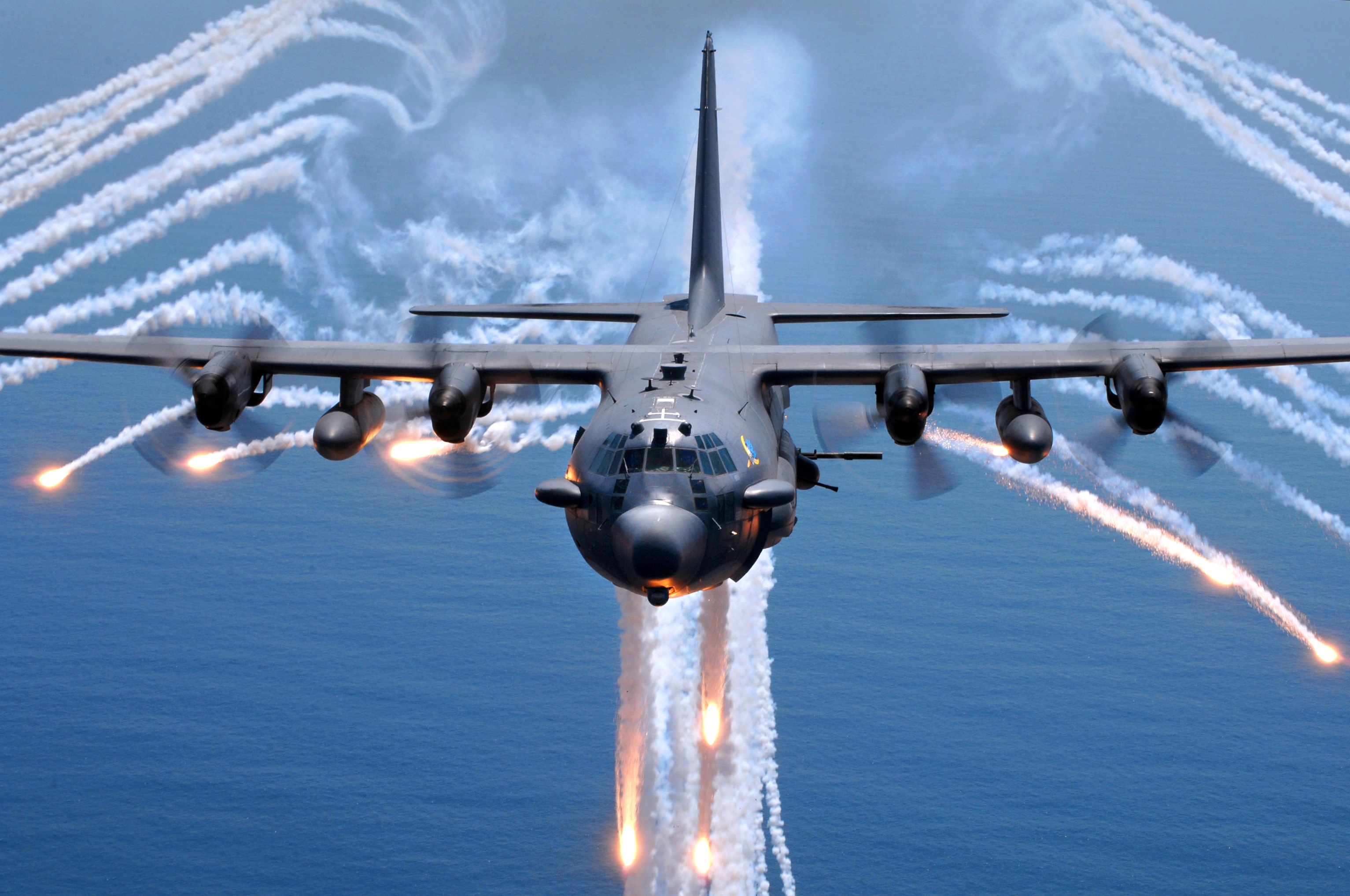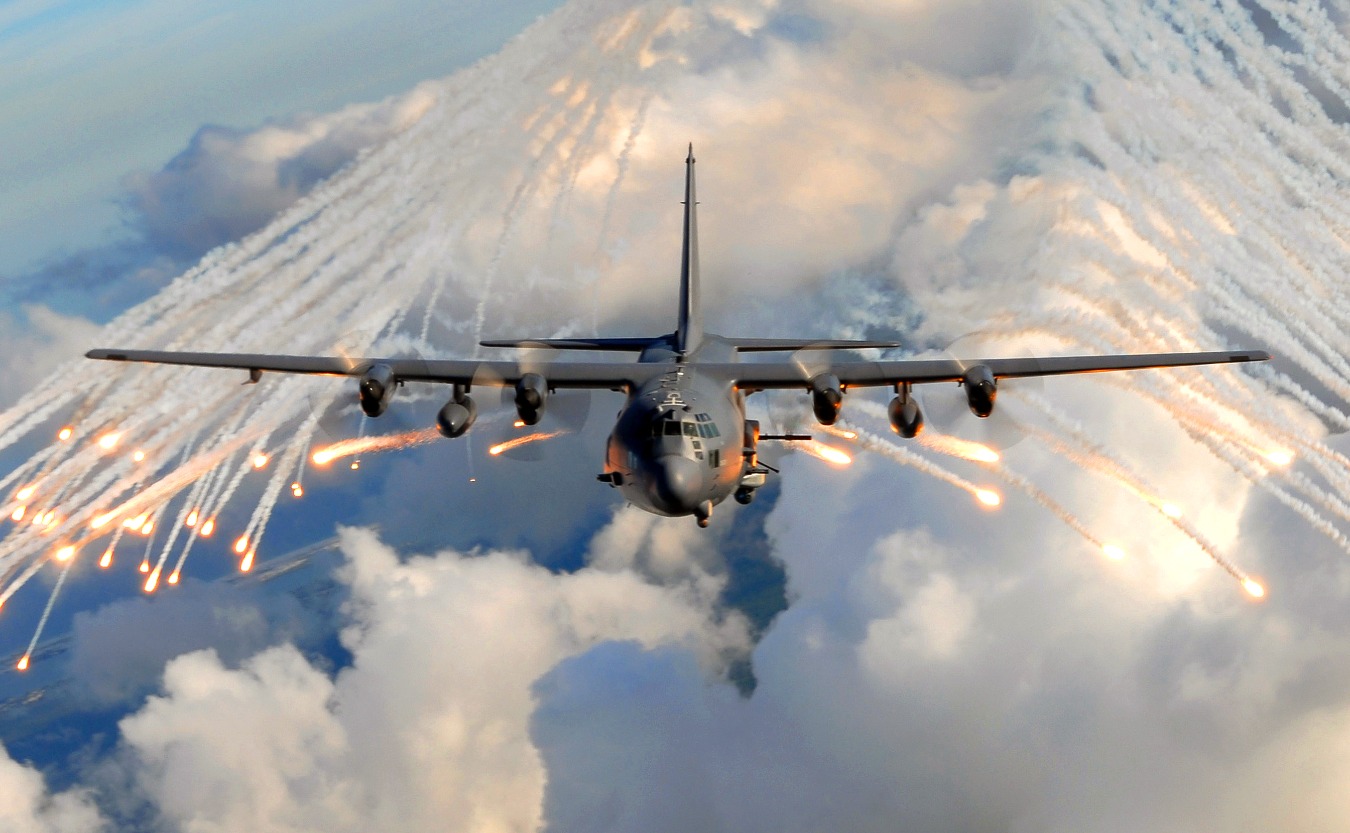The AC-130 Spectre Gunship: America’s Flying 'Battleship'
Summary and Key Points: The AC-130 "Spectre" gunship, also known as "Spooky," is a heavily armed aircraft born out of necessity during the Vietnam War to provide close-air support (CAS) in dense jungle warfare. This heavily modified C-130 Hercules transport aircraft is equipped with a variety of powerful weapons, including a 25mm GAU-12 Equalizer Gatling gun, a 40mm Bofors cannon, and a 105mm howitzer, allowing it to deliver precise and devastating firepower.

-The AC-130's unique capability to loiter over battlefields and provide sustained fire support has made it an iconic and effective tool in America's military arsenal. Despite being a large, slow-moving target, the AC-130 has maintained a relatively low loss record due to advanced countermeasures and tactical adjustments.
-The aircraft has seen action in various conflicts, from Vietnam to Desert Storm, proving its enduring value and adaptability.
Meet the AC-130: The Flying Battleship
The AC-130 “Spectre” gunship (also known as “Spooky”) is less of an airplane and more of a flying battleship. Heavily armored and armed to the hilt, this souped-up C-130 Hercules transport aircraft is meant to dish out the hurt six different ways from Sunday. The AC-130’s unique origins is in the best tradition of the US military.
At the time, America was involved in one of the nastiest wars in its history: the Vietnam War. By the time the AC-130 Spectre gunships came into being, the country had been engaged in full-scale war with Vietnam for two years.
The Viet Cong guerillas fighting against Americans in South Vietnam as well as the North Vietnamese Army (NVA) regulars were masters of irregular warfare. Realizing they could not defeat the Americans in a fair fight, the North Vietnamese communists opted to fight asymmetrically.
One of their tactics when fighting the Americans in the dense jungle canopy of Indochina was to get in close, blur the lines of contact between forces, and cause general chaos and confusion among American units. Many times, American units would need air or artillery assistance and could not receive such help without risking being blown to bits themselves.
What was needed was close-air support (CAS). Nowadays, platforms like the A-10 Warthog do the job of CAS (although even that system is under attack from the bean counters at the Pentagon). But 1967 was many years before the advent of the A-10. Necessity being the great mother of invention (and desperation being its father) prompted the eggheads at the Pentagon to convert existing C-130s into flying battleships.
Some Key Facts About the AC-130
Possessing four propeller engines and meant for hauling heavy military equipment over vast distances, the AC-130 Spectre gunships traded cargo carrying capacity for cannon carrying capability. Its primary mission was to neutralize enemy ground threats while providing air cover for friendly ground forces, notably during the risky nighttime battles that US forces routinely fought in the Vietnam War.
The AC-130 could fly relatively close to the battlefield and simply hover over it for protracted periods of time while doling out a world of pain to those enemy units running roughshod below.
The AC-130 comes with a variety of weapons, including 25mm GAU-12 Equalizer Gatling gun, a 40mm Bofors L/60 cannon, and a 105mm M102 howitzer. These weapons allow the AC-130 to engage targets at various ranges and with different levels of firepower. According to a 2010 report from CIA, “These heavily armed aircraft incorporate side-firing weapons integrated with sophisticated sensor, navigation and fire control systems to provide surgical firepower or area saturation during extended periods, at night and in adverse weather.”
One of its primary purposes from back in the Vietnam War—being used during nighttime raids—was less because that’s what American planners wanted and more because of the various drawbacks of the AC-130.
As noted above, this bird was a large, propeller-driven warbird. Its maximum speed was about 416 miles per hour with a range of over 2,500 miles.
Given that it was meant to be a low-flying, lingering plane above contested battlespaces, despite its advanced and heavy weapons, it was an easy target for enemy ground forces. So, by using these birds at night, the US military cut down on the risk of losing these systems in combat.
Throughout its decades long combat history, only eight AC-130s have been lost during combat missions, with six having occurred during the Vietnam War (most to 37mm anti-aircraft guns). On the other hand, as per The Aviationist, the AC-130 “destroyed at least 20 vehicles per night during the Vietnam War.” An AC-130 even shot down an enemy helicopter.
Given how low and slow these birds fly, that’s a really great record.
Remember the Battle of Khafji
According to a 2021 article by Task & Purpose, “No enemy has downed an Air Force AC-130 gunship in combat in 30 years.” The last time one of America’s iconic flying battleships was lost was the doomed “Spirit 03” mission during the Battle of Khafji in Operation Desert Storm.
At that time, an AC-130 gunship, designated “Spirit 03” is believed to have overstayed in a combat area where there were Iraqi air defense missile systems active. The gunships are meant to be operated in darkness, but for various reasons the Spirit 03 bird was operating in semi-daylight. An Iraqi anti-aircraft crew spotted the slow-moving bird, fired, and killed all 14 airmen aboard.
Since that awful incident, or rather because of that incident, the US Air Force instituted multiple reforms that have ensured that no AC-130 has been downed since 1991. This, despite the fact that multiple wars have been fought since that time (including a second, costlier war in Iraq in 2003). Key changes made in the wake of the Spirit 03 incident in 1991 included more advanced defensive systems to help keep the bird flying in combat.
Key Enhancements Made to the AC-130’s Survivability
Electronic countermeasures, infrared countermeasures, as well as chaff and flare dispensers are all vital systems for the AC-130. What’s more, after that 1991 incident, Chief Master Sgt. Bill Walter told Task & Purpose in a 2021 interview that, “all AC-130 aircraft [are now] fitted with AN/AAR-44 Missile Approach Warning Systems. Those systems detect man-portable air defense (MANPADS) missile launches, warn crews of a threat, and automatically deploy flares.”
There were also changes to tactics made following the 1991 incident. AC-130 crews were conditioned to reduce “their exposure to enemy fire while flying loose, unpredictable orbits around the combat zone that also went to higher altitudes and lowered their chances of getting hit.”
Beyond that, AC-130 crews “cut out unnecessary crew communication procedures, used better navigation systems and night-vision goggles, and got used to breathing through oxygen masks to keep working at high altitude in the AC-130’s unpressurized cabin.”
The AC-130 is one of the greatest modern warplanes ever created. Its long service record and relatively low loss record is proof of this claim. Born out of necessity and carried forward due to high performance under extreme conditions, the AC-130 numbers among America’s most iconic military aircraft ever. It will forever be remembered as a flying battleship that gave out even more pain than it ever received.

Author Experience and Expertise: Brandon J. Weichert
Brandon J. Weichert, a National Interest national security analyst, is a former Congressional staffer and geopolitical analyst who is a contributor at The Washington Times, the Asia Times, and The-Pipeline. He is the author of Winning Space: How America Remains a Superpower, Biohacked: China’s Race to Control Life, and The Shadow War: Iran’s Quest for Supremacy. His next book, A Disaster of Our Own Making: How the West Lost Ukraine, is due October 22 from Encounter Books. Weichert can be followed via Twitter @WeTheBrandon.
All images are Creative Commons or Shutterstock.
From the Vault
Russia Freaked Out: Why the U.S. Navy 'Unretired' the Iowa-Class Battleships
Battleship vs. Battlecruiser: Iowa-Class vs. Russia's Kirov-Class (Who Wins?)


